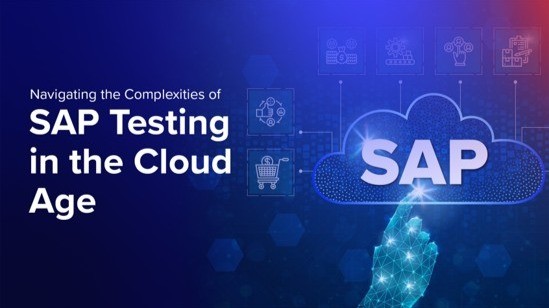Did you know that 77% of global transactions touch SAP systems? With 70% of enterprises accelerating cloud adoption, Automated SAP Testing and Cloud-Based Testing are no longer optional—they’re critical. As businesses increasingly migrate to the cloud to enhance agility, scalability, and cost-efficiency, SAP testing faces new complexities that demand innovative approaches. Navigating these challenges effectively is crucial for ensuring seamless operations, robust security, and sustained business growth.
Understanding the Shift: SAP in the Cloud Era
The cloud revolution has transformed how businesses deploy, manage, and scale their SAP systems. Cloud platforms like SAP S/4HANA, AWS, Azure, and Google Cloud offer unparalleled flexibility, enabling organizations to adapt quickly to market dynamics. However, migrating SAP applications to the cloud introduces unique testing challenges:
- Dynamic Environments: Cloud environments are highly dynamic, requiring continuous testing to ensure configurations, integrations, and customizations remain intact.
- Complex Integrations: SAP systems often interact with numerous third-party applications. Ensuring seamless integration across cloud and on-premises systems is essential.
- Security & Compliance: Data security, privacy regulations, and compliance become even more critical in the cloud, demanding rigorous cloud-based testing protocols.
Key Challenges in SAP Testing in the Cloud Age
- Performance Variability: Cloud infrastructures can experience fluctuations in performance due to shared resources. Performance testing must account for these variations to ensure consistent user experiences.
- Data Migration Validation: Migrating data to the cloud poses risks related to data loss, corruption, and inconsistency. Comprehensive data validation and reconciliation are essential to maintain data integrity.
- Frequent Updates and Changes: Cloud providers regularly update their services. Continuous testing frameworks are necessary to ensure these updates do not disrupt SAP functionalities.
- Cloud Migration Testing: As organizations embrace Cloud Migration Testing, robust frameworks become essential to minimize risks and downtime.
- Cross-Platform Compatibility: Ensuring compatibility across different cloud environments and hybrid infrastructures requires extensive end-to-end testing.
- Regulatory Compliance: Cloud-hosted SAP systems must comply with industry-specific regulations (e.g., GDPR, HIPAA). Testing should validate compliance across all operational processes.
Strategies for Effective Testing - SAP in the Cloud
- Adopt Automation-First Approaches: Implement robust test automation frameworks to handle repetitive testing tasks, accelerate release cycles, and reduce human error.
- Shift-Left Testing Practices: Integrate testing early in the development lifecycle to detect defects sooner, reducing costs and improving overall quality.
- Leverage Cloud-Native Testing Tools: Utilize cloud-native tools that offer scalability and flexibility, ensuring tests can be executed across multiple environments effortlessly.
- Continuous Testing in CI/CD Pipelines: Incorporate continuous testing within CI/CD pipelines for faster feedback loops, ensuring rapid yet reliable deployments.
- Risk-Based Testing Approach: Prioritize testing efforts based on business-critical processes and potential risk impact, optimizing resource utilization and testing efficiency.
- SAP S/4HANA Testing: The shift to SAP S/4HANA Testing demands a blend of automation and cloud agility, making seamless integrations a reality.
Best Practices for Navigating SAP Cloud Testing Complexities
- End-to-End Testing: Perform comprehensive end-to-end testing to validate integrations, data flow, and business processes across cloud and on-premises systems.
- Performance Engineering: Design performance tests that simulate real-world loads to identify and mitigate performance bottlenecks.
- Data Security Testing: Conduct rigorous security testing, including vulnerability assessments and penetration testing, to safeguard sensitive data.
- Scalability Testing: Evaluate how SAP systems perform under varying workloads to ensure they can handle future growth and demand.
- Monitoring & Analytics: Implement advanced monitoring and analytics solutions to gain real-time insights into system performance, enabling proactive issue resolution.
Emerging Trends in SAP Cloud Testing
- AI-Driven Testing: Leveraging AI and machine learning for predictive analytics and intelligent test automation.
- Test Data Management (TDM): Streamlining test data provisioning while ensuring data privacy and compliance.
- Containerization and Microservices: Adapting testing strategies to support containerized SAP applications and microservices architectures.
Conclusion
Navigating the complexities of SAP testing in the cloud age requires a strategic, flexible, and automation-centric approach. By addressing performance variability, ensuring robust data validation, embracing continuous testing, and adhering to compliance requirements, organizations can unlock the full potential of cloud-enabled SAP systems.
At Qentelli, we empower enterprises to overcome these challenges with cutting-edge SAP testing solutions tailored for the cloud era. Let us help you ensure your SAP systems remain resilient, secure, and optimized for future growth.
